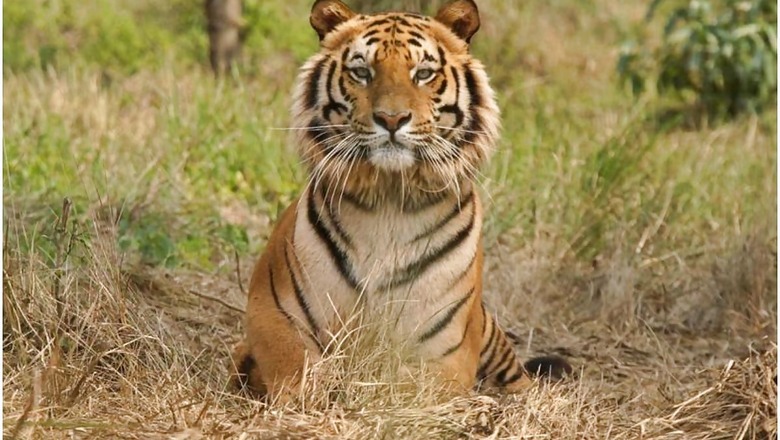
views
The increasing number of tigers at the famous Tadoba Andhari Tiger Reserve (TATR) is certainly happy news for wildlife enthusiasts. But at the same time it poses a greater threat to peaceful human-animal coexistence. More than half of the TATR area falls in the buffer zone, where 44 tigers and many leopards share space with people living in 79 villages.
Ecotourism may hold the key to drive villagers to participate in conservation activities and be tolerant of carnivores in their areas, feels the Maharashtra forest department. It has tasked the TATR officials to expand the scope and reach of ecotourism across the buffer zone. The objective is to boost the local economy by providing villagers livelihood based on tourism and recreational activities.
TATR field director Jitendra Ramgaonkar contends that the ways of revenue generation that are non-exploitative in nature would help provide means of livelihood to local villagers, who would in turn contribute to wildlife conservation.
“You have to provide alternative sources of revenue generation if you want the villagers to stay away from natural resources. Thus, we are taking a slew of measures that would build reciprocal relationships between animals and people. The villagers would ensure the wildlife is not killed or poached as it would hurt their livelihood,” he said.
The 1,727 sq km TATR is one of the oldest tiger reserves in India and is known for a guaranteed sighting of big carnivores. According to the 2018 census, there are as many as 88 tigers, though latest unofficial data shows the number nearing the 100-mark.
In the 625 sq km core area of the TATR, only jungle safari is allowed while in the rest 1,102 square kilometre buffer zone, there is scope for various other activities under the scheme of ecotourism. However, this has not been explored much yet and the jobs being created for the locals are limited to guides, SUV owners and drivers besides housekeeping staff in the private resorts.
There are some villagers who are satisfied with the higher and steady income under ecotourism. Santosh Jadhav from Kolara said over 150 people from his village get assured income of Rs 6,000- 8,000 per month during the tourism season (October -June) while SUV owners earn better.
“This year, we could not earn much thanks to the lockdown due to the coronavirus pandemic. However, we could earn a good sum till last year through different employment opportunities such as guides, drivers, hospitality staff in resorts,” he said.
Kolara village is close to the two jungle safari gates, one to the core area and the other to the buffer, which are regularly visited by celebrities. There is one more village called Alizanjha that is not as famous as Kolara but locals are confident ecotourism activities would be helpful for the improvement of their financial conditions.
One such villager from Alizanjha is Surekha Dharne, who turned half of her house into a homestay last year. She earned Rs 12,000 in the first year through 10 bookings. It may not seem like a large amount, but it matters for Dharne, whose annual family income does not go beyond Rs 30,000 after doing hard labour for about 100 days. Dharne said she can get more customers if her homestay is properly advertised.
The buffer zone has a forest area of 700 square kilometres while farmland and villages lie on the remaining 402 square kilometres, thus making wildlife management a tough task. Incidences of herbivore poaching have come from areas where safari gates were opened in the past few years, said G Guruprasad, deputy director of TATR (buffer zone).
“We have 13 safari gates in the buffer zone. No tiger reserve in the country has these many gates. The response from villagers in the TATR area has been quite positive. We have observed the population of herbivores has increased in areas where gates are opened,” he said.
“Villagers earned some money during the lockdown as jungle safari was permitted in the buffer zone. About 70 per cent of the revenue went directly to the villagers.”
These benefits, however, could only be enjoyed by a small chunk of locals. Now, nearly five-six tourism and recreational activities would be started in the buffer zone by December keeping in the mind that they influence the maximum number of villages. These activities would be organised and operated by the locals, Ramgaonkar said.
“Nature trails will be created in different villages where the situation is conducive. Also, circular cycling tracks connecting a few villages will be developed. Besides providing guide and food services, locals can build homestays. In order to make these activities more interesting, we are planning to build log hut structures on top of protection huts in buffer areas and areas close to villages, where visitors could stay overnight and do stargazing,” he said.
No stay is allowed in the core zone of the tiger reserve nor are any structures like this permitted in core zones except protection huts for patrolling staff, he said. Among other activities are development of camping sites, adventure sport facilities, education camps, museum of dioramas—3D statues of wild animals.
There is inherent fear among villagers and conservationists that private players would gradually take over these activities and eat into a major share of the revenue, leaving menial jobs to the locals. And their fears are justifiable.
“Though the ecotourism policy seeks creation and operation of accommodations by villagers, the buffer area is teeming with at least 45 resorts. Many of these are owned by high-profile people including politicians. What if the new facilities are hijacked by a private lobby tomorrow?” said a wildlife activist, who wished not to be named.
Ramgaonkar, however, asserted that almost all new revenue generation opportunities would be owned and carried out by local villagers. “Our focus is on ‘locals operate everything’. Only experts for activities such as adventure sports will be hired from outside. However, locals will be trained in due course so they take care of everything ultimately. The eco development committees (EDC) will be in charge of operations and revenue collection,” Ramgaonkar said.
If private players are kept away, the local economy would certainly improve, asserts Sandip Kumre from Alizanjha. “I bought a Gypsy vehicle for Rs 8 lakh in 2017. I earned good money and repaid my loan in just two years. There could be more like me from my village if there is no direct competition from private players. Villagers can be no match for private companies in terms of money, expertise and more importantly business development,” Kurne said.




















Comments
0 comment